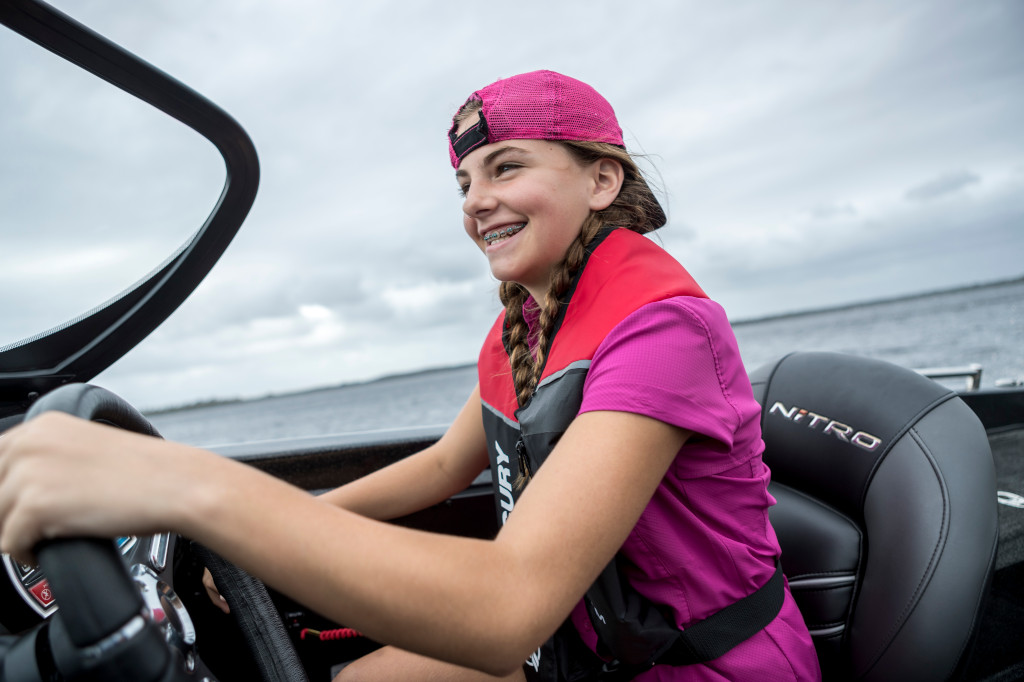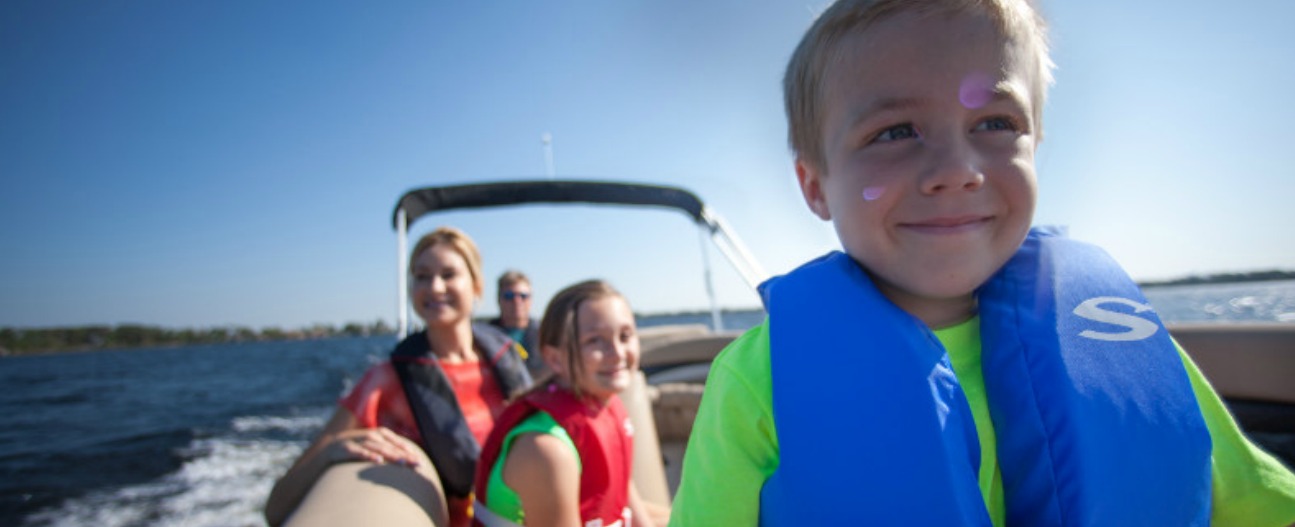Safe boating is the responsibility of everyone on the water, and it starts with making sure you have enough life jackets of the proper type and size for everyone on board.
This isn’t an area to cut corners. The best life jacket is the one you’ll wear, and you’re more likely to wear a well-fitting and comfortable life jacket than one that’s difficult to adjust or isn’t right for your body type. You also need to make sure you get the right life jacket for your activities and comfort level in the water. That goes for all your loved ones and anyone you bring along on the boat, too.
Understand the Regulations
The U.S. Coast Guard approves and classifies personal flotation devices (PFDs), including life jackets, for recreational use. Currently, anyone boating in the United States must carry on board a U.S. Coast Guard-approved life jacket for every person on the boat. Each life jacket must be in good or serviceable condition, be appropriate for the activity and meet the size requirement for the wearer. They must either be worn or kept in an easily accessible place. Federal law also requires anyone under age 13 to wear a life jacket when the boat is underway, unless riding in an enclosed cabin or below deck.
However, each state has its own regulations that must also be followed, particularly for children and special activities such as tow sports. Regulations can also vary based on the governing body or owner of each waterway – be it federal, state or local. Contact your state boating authority for detailed requirements where you boat.
 Choosing Life Jackets
Choosing Life Jackets
When you’re shopping for life jackets, all the information you need to know should be clearly printed on the label. It will show that the life jacket is U.S. Coast Guard-approved, as well as the size, type and any activity-specific requirements for safe use.
Be aware that similar-looking products known as swim aids or buoyancy aids generally do not meet the safety requirements to be considered a U.S. Coast Guard-approved life jacket.
Here’s the rundown of what you should check to make sure you choose the right life jacket, according to the U.S. Coast Guard Safe Boating Division:
1. Choose a Category
Life jackets fit into one of four categories. You should consider your activity and the likelihood of immersion when choosing. For instance, if you’re waterskiing and expect to be in the water, you’ll require a different life jacket than if you’re fishing.
Inherent – Inherent life jackets have built-in flotation (usually foam), so they’re always buoyant. They’re safe to use for all boaters.
Inflatable – Inflatable life jackets have no inherent buoyancy. They instead contain a small gas canister that inflates the vest when needed. Inflatables have become popular because they’re compact, light and comfortable to wear all day, even during activities that require a lot of movement such as fishing. However, the Coast Guard does not recommend them for weak swimmers or small children. Inflatable life jackets come in several styles, including vest-type models that auto-inflate when they become submerged and models that must be manually activated by pulling a cord. There are also waist-pack inflatables that, once inflated, must be pulled over the head.
Hybrid – Hybrid life jackets include built-in flotation plus the ability to inflate for additional buoyancy. They come in a variety of sizes and types.
Special Purpose – Special-purpose life jackets are available for certain watersports, such as waterskiing or riding a personal watercraft, and they have special features designed for their intended activity set.
 2. Make Sure it Fits
2. Make Sure it Fits
Life jackets are grouped into four general sizes:
Adult – For people who weigh more than 88 pounds.
Youth – For people who weigh 56 to 88 pounds.
Child – For people who weigh 34 to 55 pounds.
Infant – For people who weigh 33 pounds or less.
A life jacket label will also indicate the chest size, which is important for adult wearers to get a good fit.
A properly fitting foam-filled life jacket should be snug, but comfortable enough to wear for extended periods of time. If you’re not sure what size fits best for you, try one on in a store wearing the clothes you expect to wear on the water. Also, plan to do a water test before you go boating. When you wear a life jacket in the water, the life jacket should not rise above your chin or ears.
If you prefer an inflatable life jacket, follow the manufacturer’s recommendations regarding fit. Also, be sure your clothes won’t interfere with the life jacket when it inflates. Check for anything loose or bulky, particularly on rain jackets, which might get in the way of the inflation pull cord. Note, even auto-inflating models have a backup pull cord.
The last thing to remember is that the fit of a life jacket will change depending on your clothing. If the last time you wore it you were in raingear or a heavy jacket, but now you’re heading out in summertime swimwear, be sure to adjust the straps for a snug fit.
3. Pick the Right Performance Type or Performance Level
Traditionally, life jackets have been rated by performance type – Type I, II, III or V for most recreational boaters. Today, life jackets are also rated by performance level – Level 50, 70, 100, 150 or 275. You should understand both systems so you’ll always know if you have the right life jacket.
Performance Type
When choosing a life jacket based on performance type, the lower the number the higher the flotation. However, more flotation usually means more bulk and a less comfortable fit.
Type I has the greatest inherent buoyancy and can turn most unconscious wearers upright from a face-down position. They’re ideal for offshore or solo fishing, rough water, and situations where the wearer might be in the water for an extended time awaiting rescue.
Type II can turn some unconscious wearers upright from a face-down position. They work well for general boating and fishing, are less bulky than Type I but also have less flotation than Type I.
Type III can provide support to a conscious person, but they’re not designed to turn an unconscious wearer upright from a face-down position. They’re for activities in nearshore and protected waters where immediate rescue is expected, such as skiing.
Type V life jackets are designed for special applications. Consult the label and/or the manufacturer for appropriate use. You should also check your local regulations to see where and when they can be used, since some need to be worn (rather than just be on board) to meet life jacket requirements.
Performance Level
Performance level numbers indicate the buoyancy of the life jacket. The higher the number, the higher the buoyancy.
Level 50 is for competent swimmers enjoying activities close to shore and when help is nearby.
Level 70 is for boating in calm waters near the bank or shore.
Level 100 is for boaters that might need to wait for rescue, but should not be used in rough water.
Level 150 is for general applications and will turn an unconscious wearer upright.
Level 275 is for offshore use and extreme conditions.
 Storage and Accessibility
Storage and Accessibility
Where you store your life jackets when you’re on the water but not wearing them is important. They should always be kept in an accessible location where you can get to them quickly. Don’t keep them in a locked compartment. Don’t stow them in a bag. Don’t keep them below deck if you’re spending most of your time above. And don’t pile other gear on top of them.
When they’re accessible, you can get to them in an emergency, and you’re more likely to wear one more often.
Don’t Forget the Throwable
Federal law requires any boat over 16 feet to also have a Type IV “throwable” device on board to toss to someone in the water. Check state regulations for local requirements, and don’t forget to check that all your required safety equipment is functional and accessible on your boat.
For more information on safe boating practices and boating safety gear, check out this Mercury Dockline blog.
Testing and Maintenance
For most life jackets, maintenance is pretty simple. If they get wet, dry them out before storing them in the boat to prevent mold and mildew growth. Be sure to also keep them clean. Then check the straps and buckles to make sure there’s no damage. If the material is worn or ripped, or if anything is broken, it’s best to replace the life jacket. Click here to learn more about how to recognize if your life jacket needs to be replaced.
Inflatable life jackets should be checked and maintained according to the manufacturer’s recommendations.
Finally, the U.S. Coast Guard recommends that boaters try on foam-filled life jackets in the water at least once per year to check for fit and buoyancy.
Keep It On, Keep Safe
The best way to protect yourself and others on the water is by wearing a life jacket when the boat is underway. So take some time to find the right life jacket for your favorite activities and select a model that’s comfortable and appropriate. Then wear it. And make sure everyone else on board wears one, too.
If you’d like to see what some common life jackets look like and how they’re worn, check out this video from our friends at Wired2Fish.
The information included here is intended only to provide an overview of safe personal flotation device use. Safe boating is ultimately your responsibility. For detailed information about safe practices, visit the U.S. Coast Guard Boating Safety Division website at uscgboating.org. Consult state regulations for requirements where you boat and fish.
play video
